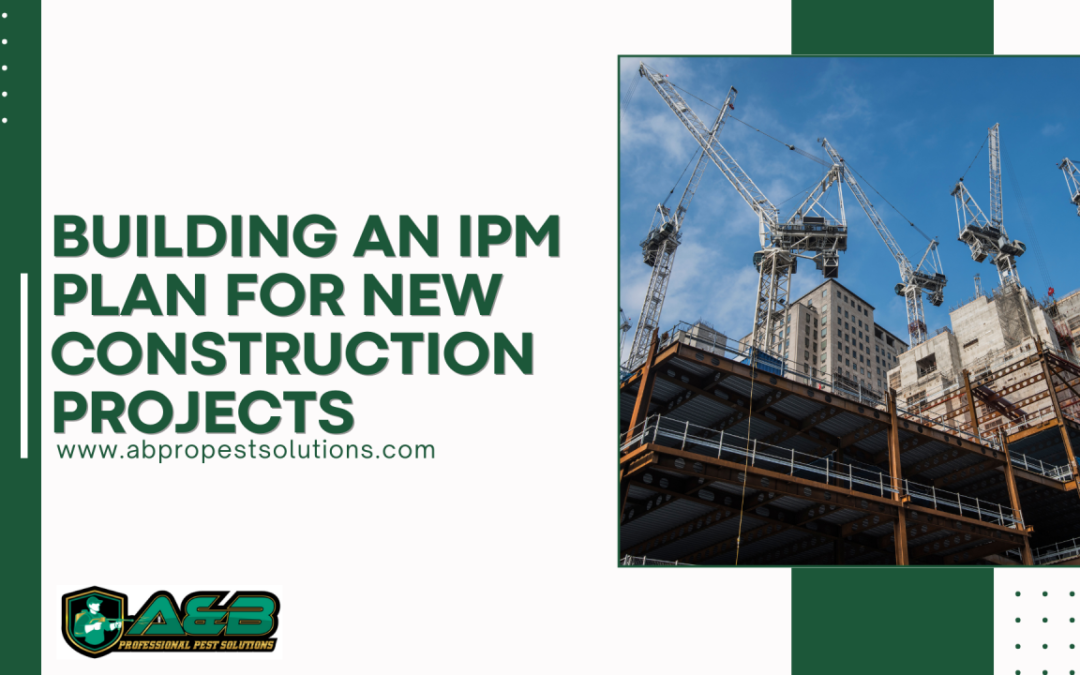Integrated Pest Management (IPM) is a sustainable approach to managing pests that focuses on long-term prevention and control through a combination of techniques. Developing an IPM plan for new construction projects is essential to prevent pest problems from the outset and ensure a healthy, safe, and compliant environment. This guide outlines the key components and steps involved in building an effective IPM plan for new construction projects.
Key Components of an IPM Plan
1. Site Assessment and Planning:
- Site Analysis: Conduct a thorough analysis of the construction site to identify potential pest habitats and entry points. Consider the surrounding environment, existing vegetation, water sources, and nearby structures that could harbor pests.
- Risk Assessment: Evaluate potential pest threats specific to the location and planned building use. Identify high-risk areas and factors that may attract pests, such as food storage areas, waste disposal sites, and utility entry points.
2. Design and Construction Practices:
- Structural Barriers: Incorporate pest-proofing measures into the building design. Use materials and construction techniques that minimize gaps, cracks, and other entry points for pests. Ensure that doors, windows, and vents are well-sealed and screened.
- Landscaping and Vegetation Management: Design landscaping to minimize pest habitats. Avoid planting trees and shrubs close to the building, and ensure proper drainage to prevent standing water, which can attract pests like mosquitoes and rodents.
3. Preventive Measures:
- Sanitation Protocols: Establish sanitation standards for the construction site, including proper waste management, regular cleaning schedules, and immediate disposal of food and construction debris.
- Exclusion Techniques: Implement physical barriers such as door sweeps, air curtains, and window screens to prevent pests from entering the building during and after construction.
4. Monitoring and Inspection:
- Regular Inspections: Conduct regular inspections of the construction site to detect early signs of pest activity. Use traps, bait stations, and electronic monitoring devices to gather data on pest presence and movement.
- Documentation: Maintain detailed records of inspections, pest sightings, and actions taken. This documentation is crucial for tracking the effectiveness of the IPM plan and making necessary adjustments.
5. Control Methods:
- Non-Chemical Controls: Prioritize non-chemical methods such as biological controls, habitat modification, and mechanical traps. Use natural predators or microbial agents to manage pest populations without harming the environment.
- Targeted Chemical Treatments: When chemical treatments are necessary, use targeted applications to minimize exposure and prevent contamination. Select environmentally friendly pesticides and follow safety guidelines.
6. Employee Training and Education:
- Staff Training: Educate construction workers and staff on IPM principles and practices. Train them to recognize pest signs, maintain sanitation standards, and report pest sightings promptly.
- Continuous Education: Keep employees updated on new pest management techniques and regulatory requirements through regular training sessions and workshops.
Steps to Implement an IPM Plan
1. Develop a Comprehensive IPM Plan:
- Create a detailed IPM plan that outlines specific actions, responsibilities, and timelines. Ensure that the plan is tailored to the unique characteristics of the construction project and location.
2. Engage Stakeholders:
- Involve all relevant stakeholders, including architects, contractors, landscapers, and pest management professionals, in the development and implementation of the IPM plan. Collaboration ensures that pest management considerations are integrated into all phases of the project.
3. Monitor and Adjust:
- Continuously monitor the effectiveness of the IPM plan through regular inspections and data analysis. Adjust strategies as needed based on monitoring results and changing conditions on the construction site.
4. Review and Improve:
- After the construction project is completed, review the IPM plan and its outcomes. Identify areas for improvement and update the plan for future projects. Share lessons learned with all stakeholders to enhance the effectiveness of IPM in future construction efforts.
Implementing an IPM plan for new construction projects is a proactive and sustainable approach to pest management. By integrating preventive measures, regular monitoring, and targeted controls into the construction process, you can create a pest-resistant environment that ensures the health, safety, and compliance of the building. Engaging stakeholders and continuously improving the IPM plan will contribute to long-term success in managing pest issues effectively.
To know more about A&B’s services, please visit the A&B’s website (www.abpestsolutions.com.ph) or Facebook Page (https://www.facebook.com/ABPestSolutions/) to know more about their services. A&B also disinfects workplaces or houses to kill COVID-19 Virus.
You may also contact: +63 905 496 4550 and +63 951 062 4830
A&B Professional Pest Solutions Corporation is located at the Ground Floor of Monterey Building at Genesis St., Centro de San Lorenzo, Santa Rosa, 4026 Laguna, Philippines

